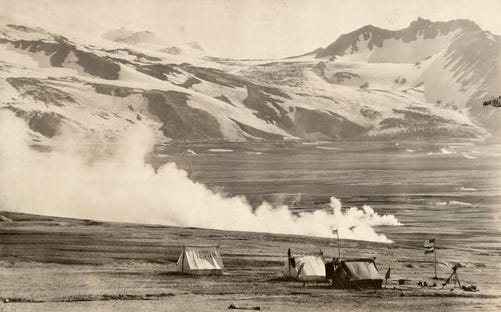By Jordan Schaul | National Geographic | May 24, 2012
In celebration of the 100th Anniversary of the Valley of 10,000 Smokes Contributing Editor Jordan Schaul explores the history of this great volcanic event, which shaped part of Alaska’s landscape.
It may sound like a fictional destination in an Indiana Jones film, but the Valley of 10,000 Smokes is the real deal. Here in the Last Frontier, where earthquakes and biting cold weather can rattle the soul, is a pristine and a magical, yet unforgiving wilderness—all shaped by a volcanic eruption.
Known for its large population of brown bears, rugged coast, and volcanoes—Katmai is no place for the faint of heart.
It was the aftermath of a volcanic eruption with a Volcanic Explosivity Index (VEI) of 6 that drew Dr. Robert Fiske Griggs on a National Geographic Society expedition to the Katmai coast in 1915. What is left of the summit of Mount Katmai—a composite volcano—is a 4 square mile caldera or what volcanologists call a volcanic crater. The center of the crater now supports a crater lake, as a result of a collapsed mountain. The actual eruption occurred 6 miles west of the summit of Mount Katmai at a vent that we now call the Novarupta volcano.
Griggs, a botanist, and 11 other explorers traveled the ash-covered terrain to study the temperatures and substrate layers of the Katmai River Valley in the wake of the 1912 Novarupta volcano. From June 6th to June 8th of that year, Novarupta which translates to “New Eruption,” expelled 30 times the volume of magma that was produced during the 1980 volcanic eruption of Mount Saint Helens, making it the largest volcanic eruption of the 20th Century.
Included in the tephra or pyroclasms—the fragments of rock spewed into the air during a volcanic eruption—is volcanic ash, which includes pulverized rock. These tiny fragments of the Earth were ejected from Mount Katmai’s volcanic vent; and they buried everything in sight, including the Ukak River Valley. As the Ukak River’s water heated, the ash ascended, escaping through fissures and cracks in the Earth’s surface. The opening or fumaroles allowed steam and other gases to rise into the atmosphere, giving the valley its name.
Although the “smokes” are gone as the volcano has cooled, the depositional process is visible and represented in the composition of geologic formations that exist in the area today—an area now known as Katmai National Park and Preserve.
Not far from the famed Brooks Camp, which is one the most famous bear viewing venues in the world, is Griggs Visitor Center. The Center serves as an observation area and shelter, and a hub for visitors interested in touring a portion of the Valley of 10,000 Smokes. The facility is open only during the summer and hours of operation are available on the National Park Service website.
ABOUT NATIONAL GEOGRAPHIC SOCIETY
The National Geographic Society is a global nonprofit organization that uses the power of science, exploration, education and storytelling to illuminate and protect the wonder of our world. Since 1888, National Geographic has pushed the boundaries of exploration, investing in bold people and transformative ideas, providing more than 14,000 grants for work across all seven continents, reaching 3 million students each year through education offerings, and engaging audiences around the globe through signature experiences, stories and content. To learn more, visit www.nationalgeographic.org or follow us on Instagram, Twitter and Facebook.
MEET THE AUTHOR
Jordan Carlton SchaulWith training in wildlife ecology, conservation medicine, and comparative psychology, Dr. Schaul's contributions to Nat Geo Voices have covered a range of environmental and social topics. He draws particular attention to the plight of imperiled species highlighting issues at the juncture or nexus of sorta situ wildlife conservation and applied animal welfare. Sorta situ conservation practices are comprised of scientific management and stewardship of animal populations ex situ (in captivity / 'in human care') and in situ (free-ranging / 'in nature'). He also has a background in behavior management and training of companion animals and captive wildlife, as well as conservation marketing and digital publicity. Jordan has shared interviews with colleagues and public figures, as well as editorial news content. In addition, he has posted narratives describing his own work, which include the following examples: • Restoration of wood bison to the Interior of Alaska while (While Animal Curator at Alaska Wildlife Conservation Center and courtesy professor at the University of Alaska) • Rehabilitation of orphaned sloth bears exploited for tourists in South Asia (While executive consultant 'in-residence' at the Agra Bear Rescue Center managed by Wildlife SOS) • Censusing small wild cat (e.g. ocelot and margay) populations in the montane cloud forests of Costa Rica for popular publications with 'The Cat Whisperer' Mieshelle Nagelschneider • Evaluating the impact of ecotourism on marine mammal population stability and welfare off the coast of Mexico's Sea of Cortez (With Boston University's marine science program) Jordan was a director on boards of non-profit wildlife conservation organizations serving nations in Africa, North and South America and Southeast Asia. He is also a consultant to a human-wildlife conflict mitigation organization in the Pacific Northwest. Following animal curatorships in Alaska and California, he served as a charter board member of a zoo advocacy and outreach organization and later as its executive director. Jordan was a member of the Communication and Education Commission of the International Union for the Conservation of Nature (CEC-IUCN) and the Bear Specialist Group of the IUCN Species Survival Commission (BSG-SSC-IUCN). He has served on the advisory council of the National Wildlife Humane Society and in service to the Bear Taxon Advisory Group of the Association of Zoos and Aquariums (AZA Bear TAG). In addition, he was an ex officio member of the council of the International Association for Bear Research and Management.



